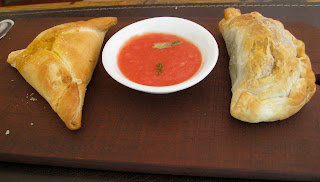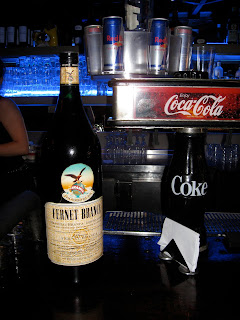Tonight was the opening night for the new Colicchio&Sons restaurant in the old Craftsteak space. I happened to be getting a reservation for last Friday on
Opentable and happened to notice that Colicchio&Sons was taking reservations for tonight's opening night, so I decided to jump on the opportunity.
The concept for this restaurant was for Colicchio to get back to his roots and do more composed dishes as he had been doing for the last year or so at
Tom: Tuesday Dinner. I was lucky enough to attend the first of those (read about it on a blog and got in off the waiting list due to a last minute cancel), as well as a similar in style special '
Farm-Maker Dinner', so I was already well sold on the concept.
We got there a bit early and enjoyed a drink in the "Tap Room." I started with a Cinnamon Sidecar while deciding on the wide variety of choices for brews on tap.
I settled on the delicious, albeit expensive, Italian Pausa P.i.L.S. after my starter cocktail.
But on to the main fare. I started with the "Roasted Sweetbreads with Honey Onions & Bacon-Sherry Vinegar":
Mmmm, these were fantastic. They only served to highlight the differences I observed and
spoke about in the sweetbreads available in Argentina vs those I can get here. These had the mild creamy flavor I love with a nice acidity and sweet balance from the accouterments.
I also tried the "White bean Agnolotti with Chorizo, Pork Belly & Octopus":
What's not to love about that? It was luscious and richer that I expected, but in a good way and not so much that it scared the wife away (this was her order and she loved it, but she often doesn't like rich dishes as much as I, eg scallops, foie gras.)
She ordered as her main course the "Lamb Loin with Merguez Sausage and Lentils":
I think the picture speaks for itself, but I was especially happy with the bite of "Venison with Turnips, Black Trumpet Mushrooms & Quince":
I'm normally disappointed with Venison steaks, as I often find them a bit lean and while having decent flavor, a bit boring. Not this one; it had excellent gaminess but still rich and intoxicating texture and flavor, very well done.
We had one vegetarian amongst us, and while I didn't taste her gnocchi sans bone marrow (a shame, I know), I did get this pic:
I was very torn for my choice of main, I've had Colocchio's Sturgeon a couple times before and loved it, and I'm always a sucker for Duck, as well as tempted by the Sirloin, but in the end I think I won by going with the "Capon 'Pot Au Feu' with Crispy Skin and Black Truffle":
This is not a dish I would typically order, but it was a real winner. The meat was perfectly cooked, with a rich consommé and a variety of textures from the white meat, the dark meat, and the velvety richness of what I assume was the liver. Yum, fantastic.
I'm not big on desserts, but we did get some excellent cheese, as well as a Banana Pecan upside Down Cake:
Botttom line, this place serves great stuff and some composed dishes you might find at the Tom: Tuesday Dinners over the last year or so. This is top notch food, and if they eventually decide to offer a tasting menu it could be really special, and judging by how hard it was to get into Tom: Tuesday Dinner, also something the city may be clamoring for. (I got in the first time, and tried calling and failed on many other occasions. I'll also allow that perhaps the exclusivity made the demand seem higher than it otherwise would, but having tried it, I'd say the demand was warranted.)
If you are interested in trying to decode the other dishes we didn't get, here are some shots of the menus outside:

 The first
The first 













































